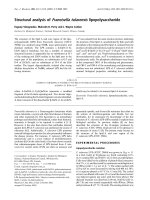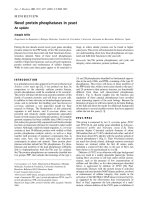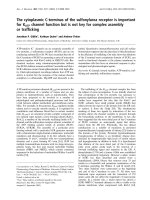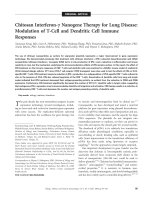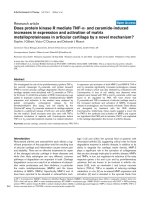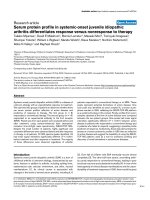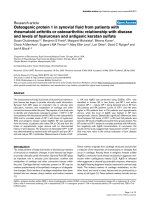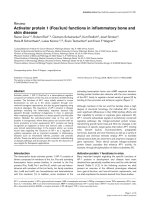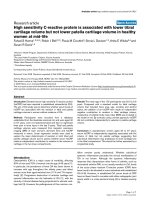Báo cáo y học: "Activated protein C: cost-effective or costly" pot
Bạn đang xem bản rút gọn của tài liệu. Xem và tải ngay bản đầy đủ của tài liệu tại đây (36.25 KB, 2 trang )
Page 1 of 2
(page number not for citation purposes)
Available online />Abstract
The authors offer a commentary on the study by Dhainaut et al. on
the cost-effectiveness of activated protein C in severe sepsis.
Using data from “real world” conditions, the results of this
economic evaluation are consistent with previous analyses, and
highlight the need for “real world” investigations of new health
technologies in critical care.
Dhainaut and colleagues in the French study group
PREMISS (Protocole en Réanimation d’EvaluationMédico-
économique d’une Innovation dans le Sepsis Sévere) report
the results of the first economic evaluation of recombinant
human activated protein C (APC) in patients with severe
sepsis performed using “real world” effectiveness data [1].
Economic evaluations in critical care medicine are relatively
new, but given the expense of health care within an intensive
care unit (ICU), their use is likely to become more common
[2]. The unique nature of this analysis is that it estimated
effectiveness using “real world” patients treated before and
after the availability of APC, rather than basing effectiveness
on the findings of the study Protein C Worldwide Evaluation
in Severe Sepsis (PROWESS), a randomized control trial
(RCT) which was used for all previous economic evaultions of
APC [4-8]. Although using a single RCT as the basis of an
economic evaluation is common, this practice has been
cautioned against [9,10], and as such, the results of this
study are of interest.
The need for assessment of clinical and economic outcomes
after the introduction of a novel therapeutic agent is
increasingly supported [11]. Effectiveness studies, those
which examine clinical outcomes outside the strict guidelines
of RCTs, have been advocated by some as the most valid
basis for economic evaluations [9] (though arguably only after
RCTs have confirmed medication efficacy). Studies like the
present one are therefore important.
Dhainaut and colleagues prospectively collected clinical
outcome data in patients with severe sepsis who were
managed before and after the introduction of APC, with
potential biases minimized through propensity score analysis.
The authors found that although survival appeared better in
patients managed with APC, the absolute benefit (3.3%) was
lower than in the PROWESS study (6.5%) and was not
statistically significant [1,3]. Despite matching patients using
propensity score analysis, though, patients in this study
treated with APC still had slightly higher organ failure scores
(p = 0.067), and this in part may explain the noted difference.
Given that several experts have called into question the
results of the PROWESS study and have argued for new
clinical trials [12,13], it appears there is a role for generation
of new clinical evidence.
Costs in their study were collected using microcosting
methods, which are regarded as the most valid means of
measuring health care costs [2]. Not surprisingly, given the
cost of APC (€7,500 per treatment course), and the cost of
managing additional survivors, the cost of caring for patients
treated with APC was higher than for patients managed
before APC, consistent with another French study which
used data from the PROWESS study [8].
While this study is important, there are some methodological
issues. First, it should be noted that performing an economic
evaluation with effectiveness data taken exclusively from non-
randomized studies can be problematic. In fact, readers
should be cautious of economic evaluations that are based
exclusively on non-RCTs, when RCT data is available, since
Commentary
Activated protein C: cost-effective or costly?
Savtaj Singh Brar
1
and Braden J Manns
2,3
1
Department of Surgery, University of Calgary and Calgary Health Region, Calgary, Alberta, T2L 2K8, Canada
2
Department of Medicine, University of Calgary and Calgary Health Region, Calgary, Alberta, T2L 2K8, Canada
3
Department of Community Health Sciences, University of Calgary and Calgary Health Region, Calgary, Alberta, T2L 2K8, Canada
Corresponding author: Braden J Manns,
Published: 10 September 2007 Critical Care 2007, 11:164 (doi:10.1186/cc6090)
This article is online at />© 2007 BioMed Central Ltd
See related research by Dhainaut et al., />APC = activated protein C; ICU = intensive care unit; PREMISS = Protocole en Réanimation d’EvaluationMédico-économique d’une Innovation
dans le Sepsis Sévere; PROWESS = Protein C Worldwide Evaluation in Severe Sepsis [study]; RCT = randomized control trial.
Page 2 of 2
(page number not for citation purposes)
Critical Care Vol 11 No 5 Brar and Manns
non-randomized studies typically overestimate the effective-
ness of an intervention, thus biasing the analysis in favor of
the intervention. Other issues include the fact that the
PREMISS study was powered to calculate differences in cost
between the pre- and post-launch phases of APC [1], but
was underpowered for assessing differences in effectiveness.
Despite that, the authors base effectiveness estimates
exclusively on their cohort data, without considering sensitivity
analyses using PROWESS data. One last issue was that
clinical outcomes were not discounted, which would be
favorable to APC – these should have been tested with
sensitivity analysis.
All in all, the results of this study are consistent with previous
economic evaluations, and the methodological biases inherent
in this study appear to balance themselves out. The results
appear to confirm that the use of APC in the “real world” is
associated with a cost effectiveness ratio in the range of
other funded interventions [2]. It is reassuring to note that
ICU physicians in this study appeared to be using this
expensive medication in a cost-conscious manner, restricting
its use to those patients with the greatest capacity to benefit
(that is, patients with high organ failure scores who have a
reasonable life expectancy if they survive their episode of
sepsis). Despite that, though, the use of APC is still
associated with a large cost that may not be affordable within
all health care systems. When determining whether to fund
APC, the opportunity cost of this intervention must be
considered in relation to other interventions that are not
currently funded.
We are entering a new era in health care. While physicians
have been used to prescribing medications and offering
interventions without consideration of cost, this is unlikely to
continue given the rising cost of therapies. Whether an
intervention provides “value for money” will become more
important, particularly for expensive medications like APC
(where its cost is noted to approximate a physicians’ monthly
salary). Studies such as the one by Dhainaut and colleagues
will help decision-makers determine the best use of APC.
This study is also a good example of a “phase 4” economic
evaluation, though it is best interpreted in the context of the
existing randomized trial and economic evaluations.
Competing interests
The authors declare that they have no competing interests.
References
1. Dhainaut J-F, Payet S, Vallet B, Riou-França L, Annane D, Bollaert
P-E, Le Tulzo Y, Runge I, Malledant Y, Guidet B et al.: Cost-effec-
tiveness of activated protein C in real-life clinical practice. Crit
Care 2007, 11:R99.
2. Cox HL, Laupland KB, Manns BJ: Economic evaluation in criti-
cal care medicine. J Crit Care 2006, 21:117-124.
3. Bernard GR, Vincent JL, Laterre PF, LaRosa SP, Dhainaut JF,
Lopez-Rodriguez A, Steingrub JS, Garber GE, Helterbrand JD, Ely
EW et al.: Efficacy and safety of recombinant human activated
protein C for severe sepsis. N Engl J Med 2001, 344:699-709.
4. Angus DC, Linde-Zwirble WT, Clermont G, Ball DE, Basson BR,
Ely EW, Laterre PF, Vincent JL, Bernard G, van Hout B: Cost-
effectiveness of drotrecogin alfa (activated) in the treatment
of severe sepsis. Crit Care Med 2003, 31:1-11.
5. Betancourt M, McKinnon PS, Massanari RM, Kanji S, Bach D,
Devlin JW: An evaluation of the cost effectiveness of drotreco-
gin alfa (activated) relative to the number of organ system
failures. Pharmacoeconomics 2003, 21:1331-1340.
6. Green C, Dinnes J, Takeda AL, Cuthbertson BH: Evaluation of
the cost-effectiveness of drotrecogin alfa (activated) for the
treatment of severe sepsis in the United Kingdom. Int J
Technol Assess Health Care 2006, 22:90-100.
7. Manns BJ, Lee H, Doig CJ, Johnson D, Donaldson C: An eco-
nomic evaluation of activated protein C treatment for severe
sepsis. N Engl J Med 2002, 347:993-1000.
8. Riou Franca L, Launois R, Le Lay K, Aegerter P, Bouhassira M,
Meshaka P, Guidet B: Cost-effectiveness of drotrecogin alfa
(activated) in the treatment of severe sepsis with multiple
organ failure. Int J Technol Assess Health Care 2006, 22:101-
108.
9. Revicki DA, Frank L: Pharmacoeconomic evaluation in the real
world. Effectiveness versus efficacy studies. Pharmacoeco-
nomics 1999, 15:423-434.
10. Sculpher MJ, Claxton K, Drummond M, McCabe C: Whither trial-
based economic evaluation for health care decision making?
Health Econ 2006, 15:677-687.
11. Drummond M, Mason A, Towse A: The desirability and feasibil-
ity of economic studies of drugs post-launch. Eur J Health
Econ 2006, 7:5-6.
12. Mackenzie AF:
Activated protein C: do more survive? Intensive
Care Med 2005, 31:1624-1626.
13. Wiedermann CJ: When a single pivotal trial should not be
enough-the case of drotrecogin-alfa (activated). Intensive
Care Med 2006, 32:604.

